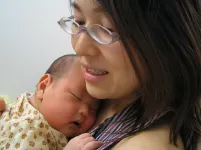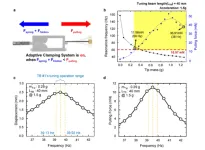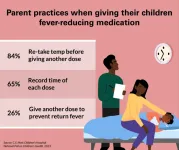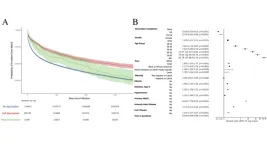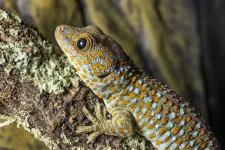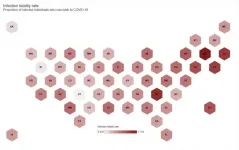(Press-News.org)
Most babies born to mothers with COVID-19 were separated after birth resulting in low breastfeeding and skin-to-skin contact rates during the height of the pandemic, according to a new global study.
The international research, led by Murdoch Children’s Research Institute in collaboration with the the European Society of Paediatric and Neonatal Intensive Care (ESPNIC), found that transmission of COVID-19 from mother to baby was rare and generally mild when it occurred. But despite this, almost half of all babies did not receive any breast milk, with only a quarter being breastfed and the majority of mothers and babies having no skin-to-skin contact immediately after birth.
Murdoch Children’s Professor David Tingay said the study, the largest on global family-centred care during COVID-19, highlighted how ensuring good infection control measures had significantly impacted neonatal practice over the past few years.
“Almost half of all newborns in the trial were denied early and close contact with their mother, demonstrating how hard it was to balance infection control measures with mother-baby bonding recommendations, especially in the first year of the pandemic,” he said. Encouragingly, clinicians did gradually adapt to allow more family-centred care as the pandemic progressed, particularly the use of breastmilk.”
The study, published in The Lancet’s eClinicalMedicine, involved 692 babies born to mothers with SARS-CoV-2 in 13 neonatal intensive care units across 10 countries , including Brazil, France, Italy and the US, who participated in the EPICENTRE trial.
It found 54 per cent of newborns were separated from their mother and only 7 per cent had physical contact before separation. Maternal breastmilk feeding rates were low at 53 per cent, with just 24 per cent exclusively fed with their mother’s breastmilk. But contact and breastfeeding increased over time from 23 per cent in Spring 2020 to 70 per cent in Winter 2020/21 (northern hemisphere seasons).
Additionally, 73 per cent of those separated from their mother were admitted into a neonatal intensive care unit or special care nursery without any symptomatic or underlying condition to account for admission. Only 5 per cent of babies born to infected mothers tested positive for SARS-CoV-2 and most cases were mild.
Murdoch Children’s Dr Georgie Dowse said the benefits of family-centred care in the perinatal period for both mothers and babies were well-established.
“Family-centred care practices such as breastfeeding, co-habitation and skin-to-skin contact are critical to the well-being of mothers and neonates, even those needing intensive care,” she said.
“Breastmilk provides a baby with nutrition and supports growth and development. Breastfeeding can help protect baby and mother against certain illnesses and diseases spanning asthma, obesity, type 1 diabetes and sudden infant death syndrome. Skin-to-skin contact helps babies adjust to life outside the womb and supports mothers to initiate breastfeeding and develop close, loving relationships with their baby.”
Professor Tingay said the impact of COVID-19 on family-centred care should be considered when updating infection control guidelines.
“The COVID-19 pandemic has created unprecedented challenges for healthcare services, including the delivery of family-centred care,” he said. Guidelines for the management of neonates born to infected mothers were initially formulated in the context of many unknowns and often varied and based on expert consensus rather than evidence.
“An encouraging finding was the increased provision of family-centred care practices as the pandemic progressed, even when the mother was very sick herself. We are hopeful doctors and nurses will use the experiences from the pandemic to better family-centred care whenever a mother or baby is unwell.
“We strongly encourage health services to continue implementing family-centred care practices during the future stages of this pandemic to ensure neonates and mothers receive the best possible health benefits.”
Publication: Dowse G, Perkins E, Stein HM, Chidini G, Danhaive O, Elsayed YN, Brunow W, Al-Naqeeb, Rooze S, Cetinkaya M, Vetter-Laracy S, Pilar-Orive FJ, Torpiano P, Gonçalves Ferri WA, Buonsenso D, Rogdo B, Medina A, Polito A, Brouwer CNM, Kneyber M, De Luca D and Tingay DG on behalf of the ESPNIC COVID-19 Paediatric and Neonatal (EPICENTRE) Registry. ‘Born into an Isolating World: Family-Centred Care for Babies Born to Mothers with COVID-19 The EPICENTRE Multinational Cohort Study,’ eClinicalMedicine. DOI: 10.1016/j.eclinm.2022.101822
*The content of this communication is the sole responsibility of the Murdoch Children’s and does not reflect the views of the NHMRC.
Available for interview:
Professor David Tingay, Murdoch Children’s Group Leader, Neonatal Research
END
Social cohesion and connection decline in an ageing population, according to a new study of one of humanity’s closest relatives.
For decades, researchers have been observing the rhesus macaques on Cayo Santiago (known as “Monkey Island”) in Puerto Rico.
Recent research showed that female macaques “actively reduce” the size of their social networks and prioritise existing connections as they age – something also seen in humans.
The new study, by an international team led by the University of Exeter, examines how this affects the overall cohesion and connection of the groups older monkeys live in.
While ...
The Internet of Things (IoT) requires the installation free of time and space, therefore, needs independent power sources that are not restricted by batteries or power lines. Energy harvesting technology harvests wasted energy such as vibration, heat, light, and electromagnetic waves from everyday settings, such as automobiles, buildings, and home appliances, and converts it into electrical energy. Energy harvesters can generate sufficient electricity to run small electronic devices by harvesting ambient energy sources without an external power supply.
The Korea Institute of Science and Technology (KIST, President Seok Jin Yoon) announced ...
For many children, winter season comes with regular exposure to circulating viruses at school or daycare. And a warm forehead is often one of the first clear signs a child has caught a bug.
But some parents may not be properly measuring or responding to elevated temperatures in children, a new national poll suggests.
While most parents recognize that a low-grade fever helps a child’s body fight off infection, one in three would give fever-reducing medication for spiked temperatures below 100.4 – which isn’t recommended – according to the C.S. Mott Children’s Hospital National Poll on Children’s Health at University of Michigan Health.
Half of parents ...
Correspondence shows troubling interactions between U.S. officials and the alcohol industry
By Kimberly Flynn
PISCATAWAY, NJ — Growing evidence exists that the alcohol industry uses a variety of strategies to influence public policy in a way that is advantageous to its own corporate interests, rather than the interest of public health. Recent communication between employees of the National Institute on Alcohol Abuse and Alcoholism (NIAAA) and alcohol industry groups shows extensive interaction on policy-relevant scientific issues, according to a new study in the Journal of Studies on Alcohol and Drugs.
Researchers at the University ...
New York, NY [February 20, 2023] – Analyzing the most extensive datasets in the United States, researchers from the Icahn School of Medicine at Mount Sinai have revealed that vaccination against COVID-19 is associated with fewer heart attacks, strokes, and other cardiovascular issues among people who were infected with SARS-CoV-2, the virus that causes COVID-19.
The research letter, “Impact of Vaccination on Major Adverse Cardiovascular Events in Patients with COVID-19 Infection,” was published in the Journal of the American College ...
Contact: Chip Colwell
chip@sapiens.org
212.683.5000
New York, NY – SAPIENS magazine is excited to share news of its 2023 poet-in-residence: Toiba Naseema. Through this position, Naseema will use poetry, film, and music to reflect on memory, occupation, and resilience in Indian-occupied Kashmir.
Naseema earned a master’s degree in mass communication, specializing in documentary filmmaking, and she is currently pursuing a master’s in anthropology at the University of Kashmir. She has been involved as an international ...
A vaginal ring containing the antiretroviral drug dapivirine posed no safety concerns when used in the third trimester of pregnancy, according to results to date from the first study of the dapivirine ring during pregnancy and one of only a few studies of an HIV prevention product in pregnant cisgender women.
The ongoing Phase IIIb study, known as DELIVER, or MTN-042, was designed to evaluate the safety and acceptability of the monthly dapivirine vaginal ring, a new HIV prevention method approved in several African countries and recommended by the World Health Organization (WHO), as well as ...
February 20, 2023 – Researchers from the University of Washington (UW), Kenya Medical Research Institute (KEMRI), and Hennepin Healthcare Research Institute (HHRI) announced results at CROI from a clinical trial demonstrating that doxycycline taken after sex does not prevent bacterial sexually transmitted infections (STIs) – chlamydia or gonorrhea – among cisgender women. The dPEP Kenya Trial was conducted in Kisumu, Kenya, to evaluate the effectiveness of doxycycline postexposure prophylaxis (PEP) to prevent bacterial STIs. The results of the study have been highly anticipated, as this is the first study of doxycycline PEP among cisgender ...
Geckos can use their tongue to differentiate their own odor from that of other members of their species, as researchers from the University of Bern have shown in a new experimental study. The findings show that geckos are able to communicate socially, meaning that they are more intelligent than was previously assumed.
Self-recognition is the ability to detect stimuli which come from oneself. We as people, and also some animals, can identify ourselves visually when we look in the mirror. However, not all animals rely on their sense of sight, first and foremost. Geckos, and also other lizards ...
Government officials and policymakers have tried to use numbers to grasp COVID-19's impact. Figures like the number of hospitalizations or deaths reflect part of this burden. Each datapoint tells only part of the story. But no one figure describes the true pervasiveness of the novel coronavirus by revealing the number of people actually infected at a given time -- an important figure to help scientists understand if herd immunity can be reached, even with vaccinations.
Now, two University of Washington scientists have developed a statistical framework that incorporates key COVID-19 data -- such as case counts and deaths due to COVID-19 -- to model the true prevalence of this disease in the United States and individual states. Their approach, published the ...
